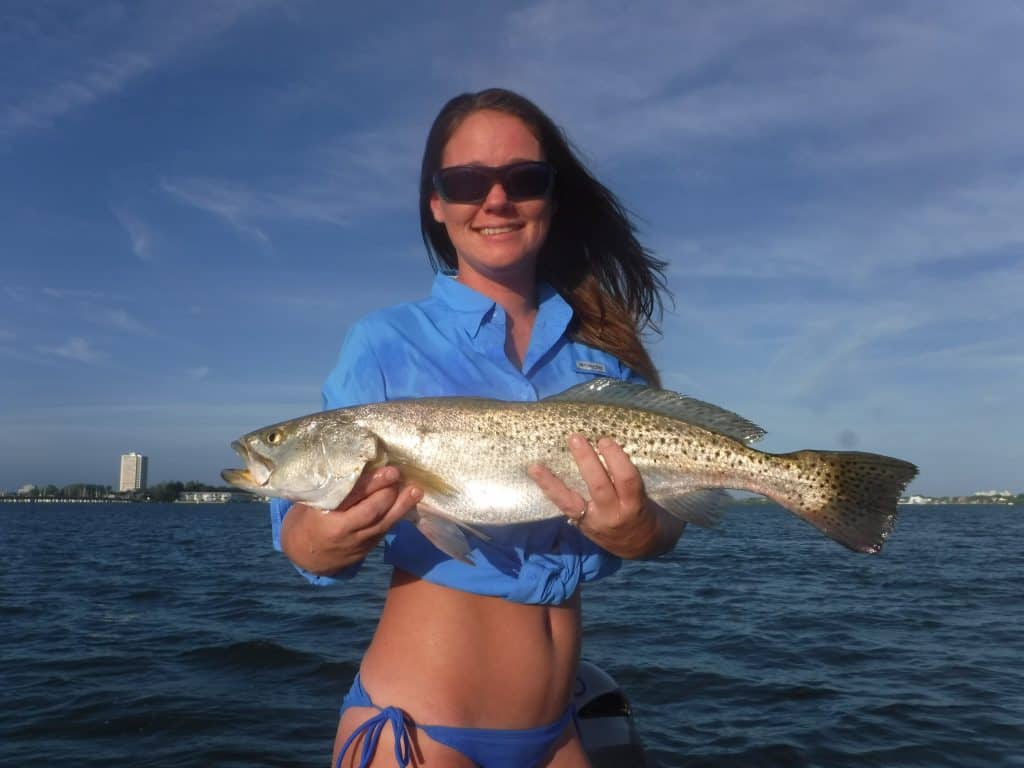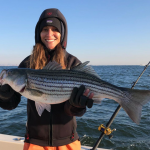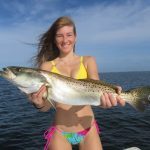Best Live Baits for Saltwater Fishing in Florida
This article will cover the best live baits for saltwater fishing in Florida. While artificial lures certainly produce plenty of fish, many anglers saltwater fishing in Florida do so using live bait. This is understandable, why use an imitation when you can use the real thing?
The top live baits for saltwater fishing in Florida are shrimp, shiners, pin fish and grunts, mullet, crabs, and sand fleas. These baits are readily available at Florida bait shops and many can be caught by anglers. They will catch every species of game fish throughout the state.
-
Shrimp
-
shiners (white bait)
-
pinfish and grunts
-
mullet
-
crabs
-
sand fleas

Some of these live baits are available for purchase at Florida bait and tackle shops. Live shrimp are a good example of this. Other baits such as shiners need to be caught by the angler. There are even “bait boats” which will go out and catch live bait fish and sell them to anglers right from their boat. Anglers can keep up to date on Florida recreational fishing regulations on the FWC site.
Live shrimp is the #1 Florida fishing bait
A live shrimp is undoubtedly the number one saltwater fishing bait in Florida. Shrimp are available at every bait and tackle shop along the coast. They are the “nightcrawler” of saltwater; every species that swims will eat one. Shrimp can be caught by anglers using a cast net. However, the vast majority of shrimp used for bait are purchased at shops.

Shrimp are fairly easy to keep alive. In the cooler months, they are very easy to keep alive. Often times, an angler can keep a couple dozen in a bucket of cool water without even using an aerator. However, in the warmer months with the water much over 70°, shrimp will become listless without some aeration. Anglers with boats usually have some type of bait well with either an aerator or a pump that recirculates the water and aerates it. Anglers without a boat use small battery-powered aerators to keep their shrimp alive.
Anglers can shop at Amazon for a Daiwa Black Gold reel and St Croix Triumph 7′ MF rod spinning combo that Capt Jim uses on his charters in this link.
“Fishing Lido Key is a participant in the Amazon Associates Program, an affiliate advertising program designed to provide a means for sites to earn advertising fees by advertising and linking to Amazon. As an Amazon Associate I earn from qualifying purchases. ”
Using live shrimp for bait in Florida
Shrimp can be hooked in a variety of fashions and fished using multiple rigs. A live shrimp under a popping cork is an extremely effective combination for catching speckled trout, redfish, and other species on the grass flats. The cork not only suspends the shrimp at the desired depth, it actually helps attract the fish when twitched sharply. Shrimp can be free lined on the flats as well. This involves simply hooking the shrimp and letting it swim naturally in the current.

Shrimp are also the number one choice for anglers bottom fishing. Many of the species in Florida are found around submerged structure such as docks, rocks, seawalls, bridges, and wrecks. A live shrimp fished on the bottom will fool sheepshead, snapper, grouper, flounder, and just about every other inshore species. This is very basic fishing. Anglers use various rigs and some type of weight to keep the bait on the bottom near the structure.
Live shiners are a terrific live bait for Florida saltwater anglers

Shiners is a generic Florida term for several families of small silvery baitfish. These include scaled sardines, also known as pilchards, threadfin herring, and Spanish sardines. Shiners, or white bait, are a terrific bait for a wide variety of species. These bait fish are found in large schools either on the flats or just offshore around markers and other structure. Anglers seeking a lot of bait catch them with a cast net. Those who only need a few baits can jig them up using a Sibiki rig.

In most cases, anglers catch their own shiners. There is a technique called “live bait chumming” were anglers use these live fish to attract game fish to the boat. This requires a lot of bait, and purchasing it would not be practical. Therefore, anglers catch their own. Shiners will die quickly if not properly taken care of. They need a constant re-changing of the water supply. This makes it impractical to fish with large numbers of shiners from the shoreline, though a dozen or two can be kept in a bucket for a little while.
When the bait is easy, anglers can put close to 1000 baits in the well in fairly short order. In some parts of Florida, guys go out early and catch a bunch of bait and sell them right from the boat. Prices and availability vary by location. Most sell the bait by the scoop. Considering the time saved, this can be a viable option.
Shiner fishing techniques
Shiners are most often free lined. This means that they are allowed to swim with just a hook in them and no other weight to hinder their movements. A split shot or two can be used to get them down in current. They are terrific baits for catching snook, redfish, jacks, trout, Spanish mackerel, and other species along mangrove shorelines and on the inshore grass flats.

Shiners are very productive on bottom species such as grouper and snapper as well. Offshore anglers use them to chum up tuna and other species off of area reefs and wrecks. In this application, they are generally fished on basic Carolina rig style bottom rigs.
Fishing with live pinfish and grunts as bait
Pinfish and grunts will be covered in one section, as they are quite similar. Both are small baitfish that kind of resemble freshwater sunfish. Pinfish are a bit rounder while grunts are a tad more elongated. Pin fish have a row of needle sharp dorsal fins, this is how they get their name. Grunts are aptly named as they make a grunting sound when in distress. Of the two, grunts are generally more desirable and pin fish are more readily available.

Some bait shops sell live pin fish and grunts, it just depends upon the area and the demand. Both pinfish and grunts do need some type of aeration or water exchanged in order to stay a live and active. Pinfish and grunts can be caught on the shallow grass flats using small hooks and pieces of shrimp or squid. They can also be caught and cast nets using canned cat food to chum them up behind the boat.
Smaller pinfish and grunts from the size of a quarter up to about 3 inches along are excellent when used in the inshore waters. They can be free lined or fished under a cork and will catch speckled trout in a variety of species. Larger pinfish and grunts are used when targeting larger fish. Snook, grouper, cobia, amberjack, tarpon, sharks, and other species will take a hand sized bait.

Mullet are productive live fishing baits in Florida
Mullet are a very popular live bait for anglers fishing in Florida. Like other bait fish, they are sometimes available at local bait and tackle shops but in most instances anglers catch their own. Most often, anglers use a cast net to procure them. Small mullet are called “finger mullet” and are terrific baits when fishing for inshore species such as trout, redfish, flounder, snook, and more. Larger mullet are used for big snook, tarpon, and even billfish offshore.

Mullet are not always easy to catch or keep alive. They are bit of a specialty bait for some serious anglers. However, there are times when finger mullet are relatively easy to find and catch. They are seen scurrying about in the shallows most often. The East Coast of Florida experiences a unique phenomenon called the “mullet run”. Huge numbers of finger mullet will hang up into bait balls and migrate down the coast. Game fish will be found ravaging the schools of bait.
Live crabs produce permit and tarpon
Live crabs are another popular live bait used by saltwater anglers in Florida. There are several types of crabs that are used, and all are effective. Once again, in some areas anglers can purchase these at bait shops while in some cases anglers catch their own. In most cases, crabs are fairly easy to keep alive as most only really need to be In a little bit of water.

3” blue crabs are used extensively as live bait for tarpon on both coasts of Florida. With the pictures usually removed, the bait is hooked through the corner of the shell and cast out towards schools of rolling fish. They are certainly the number one bait on the West Coast of Florida from Naples to Tampa. Pass crabs are caught by anglers on the outgoing tide and used as tarpon baits as well.
Blue crabs are also used by inshore anglers fishing for redfish and black drum. In most cases, the crabs should be fresh but are not used as live bait. Instead, they are cut in half’s or quarters depending on the size and fished on the bottom. This technique is used extensively in the mosquito Lagoon and banana River areas for trophy redfish.

Crabs are a top bait in the Florida Keys
Anglers fishing in the Florida Keys are quite familiar with crabs. Small crabs are used for anglers chasing permit on both the flats and the offshore wrecks. They are by far the number one bait for permit. Larger crabs are used for tarpon and other game fish.
Anglers bottom fishing for sheepshead and snapper will catch oyster crabs around the rocks on low tide. Bait shops seldom sell these crabs. However, anglers who use them swear by their effectiveness.
Sand fleas produce in the surf

Sand fleas are a bit of a specialized bait. They are most often used by anglers surf fishing sand fleas, also known as mole crabs. Are caught in the surf line. Using special rakes, anglers dredge the sand right at the surf line and sift through hoping to catch some sand fleas. They are mostly associated with pompano, however they will fool snook, sheepshead and many other species as well. Some bait shops sell them frozen, though very few sell them as live baits.

Sand fleas are terrific bait for sheepshead as well. Anglers bottom fish with them around the normal structure such as docks, bridges, rock piles, jetties, and more. Sand fleas are most often hooked by running the hook from the underside and out through the shell. The shell is delicate. Therefore, anglers should use a thin hook if possible.
Live bait fishing techniques
The three main techniques when fishing with live bait in Florida are free-lining the bait, fishing the bait under a float, and bottom fishing. These three presentations will cover most angling situations. In all presentations, the hook should match the size of the bait being used, but the fish being pursued.
Free lining baits
Free lining a bait is simply hooking it and allowing it to swim naturally. The bait is relatively free to swim about. However, the hook will cause it to swim in distress and erratically. A small split shot can be used if required. This technique can be used in any water depth, from the inshore flats to offshore reefs.

Inshore, anglers cast the freelined bait toward structure such as mangrove shorelines, oyster bars, docks, sea walls, and bridges. To some degree, anglers can control or even “swim” the bait, sort of like an artificial lure. Usually, the bait fighting against the hook will trigger a strike.
Fishing baits under a float or cork
Floats, also termed corks or bobbers are simple devices. They suspend a bait at a desired depth. This is usually done on the flats, but is used offshore as well. The float supplies casting weight as well. Finally, the float gives anglers a visual reference for when a fish takes the bait.

In Florida, anglers use “popping corks”. These are floats that not only suspend the bait, they are part of the system that attracts fish. The corks have a concave face that when twitched sharply, “produces a “popping” sound. This simulates feeding fish and attracts other fish to the bait. A live shrimp under a popping cork has resulted in countless speckled trout being caught. Noisy floats such as the “Cajun Thunder” with rattles are used the same way.
Bottom fishing with live bait
Many anglers fish with live bait on the bottom and near structure. This is a very basic form of fishing that will always be productive. Many fish species feed on the bottom, especially if some type of structure is present. This can be done from a boat, pier, bridge, or shore. There are several different rigs that anglers use to present their baits on the bottom.

The Carolina Rig is very popular and effective. With this rig the line runs through a hole in an egg sinker. A swivel stops it from going further. A leader runs between the swivel and the hook. This allows fish to pick up a bait and move off with it without feeling any resistance.
High low rigs or chicken rigs are usually used for bottom fish. It is usually used in a vertical presentation. This rig allows anglers to present several baits at different depths. It is very effective for fish such as grouper, snapper, sheepshead, drum, flounder, and other species.
In conclusion, this article on the best live baits for saltwater fishing in Florida will help anglers catch more fish using bait!






